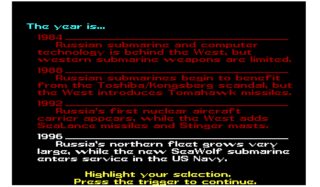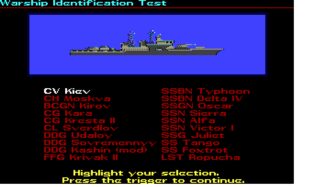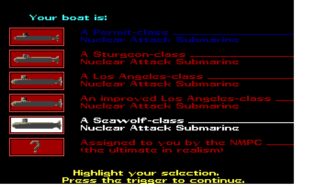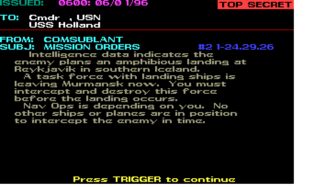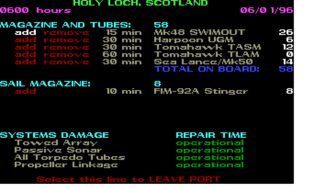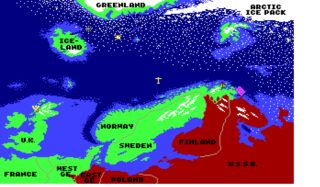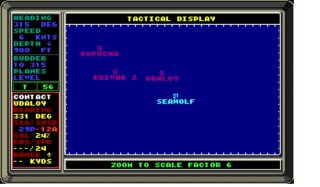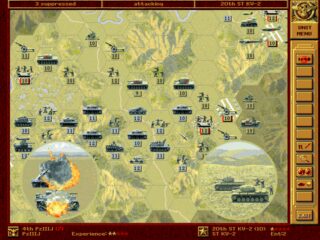Game Review
Red Storm Rising is a submarine simulation game released and published by MicroProse in 1988. The game was based on Tom Clancy's novel, also named Red Storm Rising.
Taking the player into the age of the Cold War, the game is based on the rivalry between the US and Russian naval forces. The two superpowers of the era are taking on a battle to the death at sea, and you are the winning condition; win it and be a hero or reserve yourself a place at Davy John's locker.
An average person has seen enough war movies to recognize the Captain, who yells orders at his crewmates. From the manning the torpedos, steering the sub to the boisterous commands aimed at the engine room screaming, "engines on full throttle, men," it is all etched in our memory as the typical atmosphere in a submarine control room. However, Red Storm Rising takes a much more different perspective, where it simulates the technical aspect of a submarine rather than the theatrical sense of it.
The game is based on four time zones that the player has the freedom to choose from; commanders can pitch themselves in undersea battles from 1984 to a fictitious future with advanced technology. As you prowl beneath the open sea, stalking your next victim through a bunch of maps and selection screens, it is up to the player to decide where to be, what to use, and when to use it.
The game provides the player with masses of information; all depicted through charts, graphs, maps, and even has an accurate sonar system. It's pretty much a skill and an art to go undetected and launch a guerrilla attack at an unsuspecting ship and slowly sneak away, avoiding fire. From thermal ducts in the water that distort sonar, nautical kits that function based on the submarine's depth to acoustic signatures that you can use to identify a ship, the game heavily relies on observation, skill, and strategy with massive amounts of depth involved.
Nothing related to action is complete without firepower. The game consists of a vast arsenal of weapons at your disposal and 30 odd enemy naval ships that are potential victims to your 7000 ton beast of a submarine. From torpedoes that hunt down ships to unjammable/undetectable attacks, the game provides you with an option for each scenario.
Unlike what a typical submarine simulator would provide, Red Storm Rising does not have a "cockpit" view. Instead, the whole gameplay section is based on the many maps, charts, and reading material provided by the game. From what I experienced, the lack of direct visuals didn't majorly impact the game. Trust me; when you start seeing those damage warnings and all those ships closing in on you, you will be praying to god with sweaty palms trying to save your submarine from the impending doom. The sound system doesn't give much to discuss, except the propeller churning away in the background and the occasional shake as a hit is notified.
Overall, the developers have done a fantastic job of recreating the complexity behind operating a nuclear submarine. The lack of stunning graphics or visuals may seem like a hindrance, but when you get into the playing zone, none of that matters except surviving in the deep blue sea.
 Review by: Adam
Review by: Adam
Published: 4 March 2020 10:20 pm
Users Reviews
Red Storm Rising ... Game published towards the end of the 80s, various versions have been released, such as that of the Commodore 64/128, this one on Amiga and also on MS-Dos. Versions for PC 98 and Atari ST have also been released. In short, a title that has had a wide interest. It is a simulation of a nuclear-powered attack submarine. The game is divided into different historical situations and goes from 1984 to the then future 1992. Obviously the weapons, which can be used, reflect the actual availability with respect to the historical context chosen. So, just to give an example, long-range missiles will not be available in the 1984 scenario.
The submarines that can be commanded are all American and range from the first submarines of the Permit class to the super-technological Sea Wolf. It must be said that the simulation already starts on the right foot because all the submarines that can be commanded are really existing.
The game places more emphasis on gameplay than actual simulation. The degree of realism achieved with "Red Storm Rising" is still very far from that obtained on much more modern titles, such as "Dangerous Waters". The Microprose game emphasizes practicality instead of rigorous research into the exact use of the equipment supplied to modern nuclear submarines. However, the game is equally very engaging, with an undoubted degree of suspense.
The scenario where the game operates is that of the cold war, where the friction between the United States and the former U.S.S.R. they take on alarming tones of open warfare. There are training missions, specially designed to familiarize you with the game's controls, which are quite numerous. It then continues with other single missions here too, the aim is to bring a certain experience to the player who faces this type of game for the first time. It ends with the actual campaign, the real central point of the simulation.
It begins by tracing well-known filmographies, books and short stories on the subject. It would all begin with a Soviet energy crisis, caused by an attack on the country's most important oil refineries. To solve it, we think of the oil sources of the Middle East. However, this would unleash a war against NATO (the events of these days seem to justify this sort of very worrying prediction). A motive is needed that the U.S.S.R. can exploit to appear on the side of reason and at the same time to melt Western allies. Then a fake attack on the Kremlin is tackled, placing the blame on Western terrorism. In this way, the Soviets can attack, with Westerners in full confusion.
Here the real game begins, the enemy tries to ensure dominance from the Arctic Circle to the Channel Strait, using his own powerful navy. Subsequently he will try to take over Iceland, from whose bases it will be possible to directly threaten the convoys coming from America. It will then be the turn of the entire sector of the central Atlantic Ocean to be hit by the strength of the Soviet navy. At that point, with Europe virtually isolated from American aid, the Soviets should have an easy time with the remaining allied forces in central Europe. Once NATO forces have been driven out of West Germany, the Soviets might consider a full-scale invasion of the UK as well!
This is the ultimate goal of the forces managed by the computer, to achieve these objectives, landings in the Norwegian Sea area will be carried out, then raids with submarine groups to ensure control of some vital ocean areas, acting as a pioneer for the arrival of cruise submarines, specially equipped to attack the allied ship that shuttles between America and Europe. Force projections will also be carried out across the North Sea using powerful missile cruisers. Groups of "commandos" troops will also be employed, transported aboard special submarines with very silent propulsion, which should throw our rear into turmoil.
Our task? ... Very simple, to avoid all this!
We will have to confront the best of the Soviet naval forces of the time. Furthermore, we will always be alone, this is an aspect that should always be kept in mind. Never hope for any help, all we can count on is in our reserves, which however capable they may be will soon be emptied and in need of being restored to new. Therefore we will also have to calculate our engagements with the enemy in order to calculate our pause to return to base and rearm.
This is an aspect of the game that must certainly be remembered ... that is, even if we are stopped to rearm, refuel, or repair ourselves, the game calendar goes on! The orders that the command gives us are different from game to game, when he engages you in a particular mission you must respect a certain engagement time, if we delay too much in engaging that specific enemy, he will be able to complete his mission. For example we have been chosen to prevent a landing of enemy commandos, we are short of ammunition, we are tired and we also have damage to our submarine, caused by previous missions, despite having been ordered to intercept the enemy, we decide to do route to the base for the necessary refueling operations. Well for every weapon unloaded or loaded, there is a certain amount of time that elapses ... time in which the enemy is free to continue towards his goal. It may happen that we manage to recover, but we receive the bad news from the command that the enemy has managed to disembark his men ... We have failed! We don't lose the whole game, but now the enemy has a good advantage over us and recovering that disadvantage will be tricky! So watch out, know how to evaluate well if ... how and when to proceed for any visits to your base! Getting it wrong at this stage could make you find yourself on the losing side.
The various versions came out with a special mask to be applied on the computer keyboard. This is to easily find the various commands, which were often double keys, such as "Shift + 5" and so on, difficult to remember. So, if you want to play this simulator, you should find, at least a manual or document, on which to find the main commands of the game marked.
As for the game, it is divided into a strategic phase, where you have to move on the game map, in this phase if you move using only the cursor keys or the joystick you will move at low speed, if instead you also use the "key" fire "then you will move at great speed, but you will be discovered even earlier. It is better to alternate the two speeds. Keep in mind also another thing, almost always, at sea, there will never be ONLY, your enemy to intercept, but also his escort group. Be careful, colliding with the escort group will make you gain only a few points of merit, indeed if the group is formed with low quality ships, the score may also be negative !!! So you will have wasted effort, time and weapons and you may have risked taking some damage. Even in these cases, keep your eyes open. Generally the experience will be able to give you a hand, in fact when you approach the enemy, fatally sooner or later, you will be discovered, the group that is part of the escort, so NOT your target, it will be the one that will rush on you, while your target will tend to flee far away. When this happens, you have already figured out who to attack and who to avoid.
Once you enter the combat phase you will be in the tactical phase. Here your destiny is decided, if you know how to exploit the superior technical capabilities of your submarine then you will come out as winners.
As for the fight, I have to postpone you to a separate session because it could be long to explain.
Combat Phase Of Red Storm Rising
As for the fight ... well! The first suggestion is to gain speed in training in quickly finding the various combat positions.
The game provides very advanced ways of conducting combat, there will not be only your torpedo or that of the enemy in the water, as a method of conducting the fight. In fact, there are tactical screens that include the offensive and defensive phases. All managed by an important series of data on your weapons and those launched by the enemy. There is also talk of sea conditions in the combat zone.
So the environment is also important. The manual provides a very detailed explanation on the subject, I will have to summarize quite a lot. I say that in the sea there are points where the water does not have the same physical conditions in the entire affected area. In the depths of the sea, sightings are not made through sight, which especially under the surface of the sea is very limited, the sense that identifies the enemy and announces you to the enemy is the ... SOUND ... The sound waves, which a boat sailing in the water produces, are widespread throughout the surrounding environment, where it is able to propagate well and where it propagates only minimally depends on the physical conditions of the sea. If the water is turbulent, the sound propagates badly. If the water is cold, then the sound is directed towards the bottom of the sea and then bounces back upwards when it hits the bottom or when it goes down to the bottom, the sound encounters a very strong water pressure. Conversely, when the water gets warmer then the sound is refracted towards the surface, and then bounces back to the bottom and repeat the cycle. Now, the water from the surface and towards the bottom of the sea has a gradual cooling, however if the affected sea has a depth of around 4000 feet, it can happen that at a certain depth, which varies from sea area to sea area, the water has a sharp drop in temperature, accompanied by changes also in pressure and in its physical composition. Well, that point is called a Thermocline or "Thermal Layer". This is an area that tends to block out a lot of sound by letting very little of it pass to the other side. If you are engaged in a stealth tactic, exploiting this phenomenon can help you. In fact, if you place yourself so that between your depth and that of the enemy there is the thermal layer zone, the possibility that the enemy locates you, decreases considerably.Remember that the enemy can detect your position if you navigate at high speed, while if you travel too fast you will never be able to detect it.
For weapon firing, I prefer the torpedo attack, because, unlike a missile, it will not reveal your position to the opponent, cannot be destroyed by anti-aircraft, and often hits lethally. I tend to reserve the missiles for auxiliary ships, troop transports, tankers, etc ...
Pay close attention to the enemy helicopters, if they spot you, they can arrive at your position in no time.
However, it always happens that enemy weapons locate us. Then it is necessary to conduct evasive techniques, but which must immediately lead you to find your best weapon that is invisibility. You have at your disposal, to deceive enemy torpedoes, some "noisemakers", better known as "false targets". Then there are the "Decoy", that is devices that simulate the presence of a real submarine! Finally, even the sudden maneuvers can cause eddies in the water that are very similar to the noisemaker, but with a shorter duration.
The technique for releasing these countermeasures requires that you are at a certain distance, at a certain speed and at a certain angle from the enemy threat. Once the decoy is released, remember to turn in a different direction than the enemy torpedo. The enemy weapon thus deceived, will bring its artificial intelligence into play, and will make a few turns at different depths, if you are still around it will hang you up again!
Remember that both noisemakers and decoy are not infinite, on the contrary they are limited, try to make good use of them! And always remember to counterattack, even if you don't sink the enemy, he will be busy escaping your torpedo and at high speed he will no longer be able to track your position.
Sorry for the length ... but the game deserves this kind of explanation!
 Review by: Maurizio Petta
Review by: Maurizio Petta
Published: 21 July 2022 12:29 am


